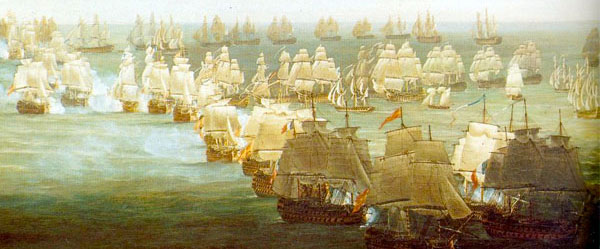 In the last days of the age of sail, British sailing ships, limejuicers, as they were known, had reputation as “hungry ships,” of offering poor quality provisions and not much of those. Whether that reputation was or was not wholly justified at the end of the 19th century, a new study now reveals that sailors in the Georgian Navy were well and amply fed for their day. Given that the British Navy had to feed upwards of 140,000 seamen and marines, the Victualing Board seems to have done a remarkably good job.
In the last days of the age of sail, British sailing ships, limejuicers, as they were known, had reputation as “hungry ships,” of offering poor quality provisions and not much of those. Whether that reputation was or was not wholly justified at the end of the 19th century, a new study now reveals that sailors in the Georgian Navy were well and amply fed for their day. Given that the British Navy had to feed upwards of 140,000 seamen and marines, the Victualing Board seems to have done a remarkably good job.
Georgian-Era British Sailors Lived on Ample Meat and Beer, Study Shows
When sailors sat down to meals fresh—or, rather, cured—from the galley 200 years ago, was it really all meager portions and scurvy-inducing blandness? Not for the men of the British Royal Navy, according to a study of bones excavated from naval cemeteries. Not only did a chemical analysis reveal that the seamen ate better than marine lore might have us believe, it also offered clues about where their units might have served.
Documents maintained by the Victualing Board belie the widespread perception that Georgian-era sailors barely scraped by on hardtack and rancid gruel. True, they ate hardtack—emblazoned, during Queen Victoria’s reign, with the monarch’s insignia—but they also drank an entire gallon of beer per day and consumed beef or pork four times a week. Along with kegs and salted meats, naval vessels carried dried peas, oatmeal, butter, cheese and sometimes even livestock for slaughter.
Records show that 18th- and 19th-century British sailors enjoyed a high-calorie, protein-packed diet superior to that of most working-class landlubbers, who typically tasted meat, beer, cheese and bread just once a week. But did the Victualing Board’s meticulous provisioning system remain intact when the going got tough on the high seas or in the thick of battle? To find out, researchers led by Mark Pollard from the University of Oxford performed an isotope analysis on bones from skeletons unearthed at naval cemeteries in Plymouth and Gosport, both in southern England. This type of test can determine what humans and animals ate during their lifetimes.
The results were consistent with the Victualing Board’s records, suggesting that British sailors ate more food—and especially more protein—than their working-class civilian contemporaries, the researchers reported recently in the American Journal of Physical Anthropology.
Finally, the researchers compared their findings to a 2009 study involving the bones of sailors from the British warship Mary Rose, which sank in July 1545. They determined that the British naval diet remained virtually the same between the 16th and 19th centuries. Change finally came with the widespread use of canning in the 1840s

Maybe I read too much fiction but I’ve read a lot and they almost all say that the food was varied and it varied to poor quality. Salted meats may have traveled the world around before being fed to sailors. I question this report.
When I first read one of N.A.M. Rodger’s books — I think it was called “The Wooden World” — I remember being appalled by the menus from records of the time. I was appalled not by the paucity of variety or food but by the enormous portions and the copious amounts of liquor. The British sailor in 1780 was issued some 2 pounds of meat a day if I remember right. It took me a while to think about what these men were doing — hard physical labor, often in cold conditions, so maybe they actually needed 5,000 calories a day. But I remember thinking that if I’d eaten a diet like that for a few weeks I would be so fat I could barely move, and so drunk I would fall down if I tried.
The question of how tasty that food was is separate. It probably wouldn’t please a gourmet. But there is no doubt it was adequate in caloric content if anything like the official quantities weere actually issued. The analysis of the sailors’ mortal remains reported here seems to confirm Mr. Rodger’s account.
I must have read some of the novels the other commenter read. No question, the literature says food on board warships of the age of sail was miserable in both quality and quantity. But, conventional wisdom is often wrong. Within the limitations of food storage technology of the day, there is every motivation to keep Navy crews healthy if a country wants to get and keep control of the seas. Might it be that the RN did a better job of feeding their men, as well as a better job at gunnery, and those two factors determined who won the death struggles between Britain and France in the 18th and 19th centuries?
Neil, key words in this report are “as compared to their working class contemporaries”.